Paul Gilster's Blog, page 89
March 21, 2019
Working with the Unexpected at Asteroid Bennu
We know by now to expect surprises when we do something for the first time with a spacecraft. The latest case in point is OSIRIS-REx, which has revealed multiple unexpected facets of the asteroid Bennu, near which it has been operating since December. Consider the surface of the asteroid, a key factor in how the mission goes forward since this is a sample return mission, and that involves finding a place relatively free of surface debris from which to take the sample.
The problem: This smallest body ever to be orbited by a spacecraft turns out to be strewn with boulders. The original sample collection plan — christened Touch-and-Go (TAG) — will have to be altered, for it was dependent on a sample site with a 25-meter radius free of hazards. The OSIRIS-REx team has been unable to identify any site that meets those requirements. A new type of candidate site will have to be found, demanding higher performance using an updated sampling approach called Bullseye TAG that will be tailored for smaller sample zones.
Nonetheless, the OSIRIS-REx team remains optimistic:
“Throughout OSIRIS-REx’s operations near Bennu, our spacecraft and operations team have demonstrated that we can achieve system performance that beats design requirements,” said Rich Burns, the project manager of OSIRIS-REx at NASA’s Goddard Space Flight Center in Greenbelt, Maryland. “Bennu has issued us a challenge to deal with its rugged terrain, and we are confident that OSIRIS-REx is up to the task.”
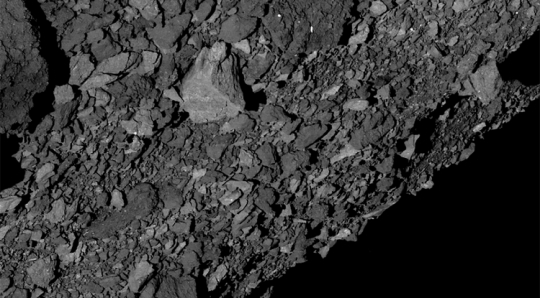
Image: Bennu’s surface is rockier than expected, creating challenges for the team whose mission is to scoop up a sample of pristine material and return it to Earth in 2023. Credit: NASA/Goddard/UA.
The larger issue facing asteroid investigations is the question of computer modeling. The reason scientists have assumed that Bennu’s surface would be generally smooth is that observations from Earth of the object’s thermal inertia and radar measurements of its surface roughness have been integrated into computer models that made this prediction. We now learn that the interpretation of these models was not correct. Indeed, data from Bennu should help us refine such models to better predict what we’ll find on the rocky surfaces of small asteroids.
A suite of papers covering the Bennu findings has appeared in Nature following presentations at the recent 50th Lunar and Planetary Conference in Houston (citations below). On the matter of Bennu’s boulder strewn surface, a team from SwRI presents results showing that the surface geology of the asteroid is between 100 million and 1 billion years old. That too can be considered a surprise, to judge from the remarks of SwRI’s Kevin Walsh:
“We expected small, kilometer-sized NEAs to have young, frequently refreshed surfaces,” said SwRI’s Dr. Kevin Walsh, a mission co-investigator and lead author of a paper outlining the discovery published March 19 in Nature Geoscience. “However, numerous large impact craters as well as very large, fractured boulders scattered across Bennu’s surface look ancient. We also see signs of some resurfacing taking place, indicating that the NEA retains very old features on its surface while still having some dynamic processes at play.”
Some of Bennu’s boulders are larger than 45 meters (150 feet) in size, much larger than earlier observations had predicted, and according to Walsh, they are simply too big to be the result of cratering. Instead, the scientist believes they date back to the formation of the asteroid.
But OSIRIS-REx (Origins, Spectral Interpretation, Resource Identification, Security-Regolith Explorer — I have to untangle the acronym once in each post on the mission) continues to seize our attention long before the sample return with the news that particle plumes are erupting from its surface. This one caught everyone by surprise as well when, on January 6, the science team discovered the plumes while the spacecraft was about 1.6 kilometers away, with further detections in the ensuing months. Some of these particles were ejected from Bennu entirely, while others returned to the asteroid. None are thought to pose a danger to the spacecraft.
“The discovery of plumes is one of the biggest surprises of my scientific career,” said Dante Lauretta, OSIRIS-REx principal investigator at the University of Arizona, Tucson. “And the rugged terrain went against all of our predictions. Bennu is already surprising us, and our exciting journey there is just getting started.”
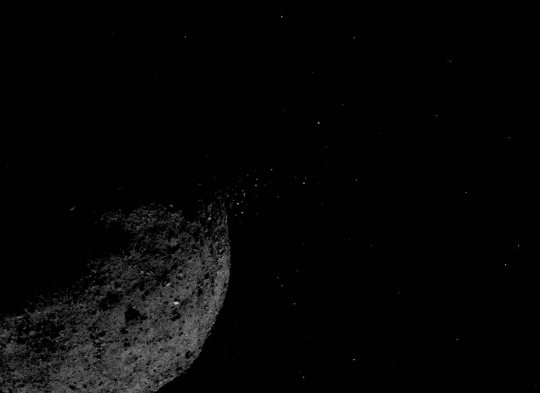
Image: This view of asteroid Bennu ejecting particles from its surface on January 19 was created by combining two images taken on board NASA’s OSIRIS-REx spacecraft. Other image processing techniques were also applied, such as cropping and adjusting the brightness and contrast of each image. Credit: NASA/Goddard/University of Arizona/Lockheed Martin.
We’ve already talked about the change in Bennu’s spin rate as an apparent result of the Yarkovsky-O’Keefe-Radzievskii-Paddack (YORP) effect (see Asteroid Bennu: Changes in Rotation Rate), a fascinating find in itself, but it’s also encouraging in terms of understanding asteroid composition to learn that the MapCam color imager and the OSIRIS-REx Thermal Emission Spectrometer (OTES) have detected magnetite on Bennu’s surface, which points to rock and liquid water interactions on the asteroid’s much larger parent body.
Learning about the sources of organic molecules and water on Earth may be enhanced by our analysis of such asteroids, and we’re also beginning to learn what resources will be available in near-Earth space. Bennu truly offers us a window into the early days of the Solar System.
The papers are Lauretta et al., “The unexpected surface of asteroid (101955) Bennu,” Nature 19 March 2019 (abstract); Barnouin et al., “Shape of (101955) Bennu indicative of a rubble pile with internal stiffness,” Nature Geoscience 19 March 2019 (abstract); Walsh et al., “Craters, boulders and regolith of (101955) Bennu indicative of an old and dynamic surface.” Nature Geoscience 19 March 2019 (abstract); Hamilton et al. “Evidence for widespread hydrated minerals on asteroid (101955) Bennu.” Nature Astronomy 19 March 2019 (abstract); Hergenrother et al., “Operational environment and rotational acceleration of asteroid (101955) Bennu from OSIRIS-REx observations,” Nature Communications 19 March 2019 (abstract); Scheeres et al., “The dynamic geophysical environment of (101955) Bennu based on OSIRIS-REx measurements,” Nature Astronomy 19 March 2019 (abstract); and DellaGiustina et al., “Properties of rubble-pile asteroid (101955) Bennu from OSIRIS-REx imaging and thermal analysis,” Nature Astronomy 19 March 2019 (abstract).






March 20, 2019
Carbon Monoxide as Biosignature?
Biosignature gases are those that can alert us to the possibility of life on a planet around another star. We’re moving into the era of biosignature observation by studying the atmospheres of such planets through instruments like the James Webb Space Telescope, and the effort to catalog the combinations of atmospheric gases that point to life is intense and ongoing.
One gas has turned out to be controversial. It’s carbon monoxide, which in some quarters has been considered to be the opposite of a biosignature, a clear sign, if detected in sufficient abundance, that a planet is not inhabited. Edward Schwieterman (UC-Riverside) begs to disagree, and a team led by Schwieterman has produced its modeling of biosphere and atmosphere chemistry to focus on living planets that nonetheless support carbon monoxide at levels we should be able to detect. The work appears in the Astrophysical Journal.
Interestingly, the paper harks back to our own planet’s deep past. We don’t expect to see high levels of carbon monoxide on life-giving planets because the gas is so quickly destroyed by chemical reactions on our oxygen-rich world. Go back several billion years, however, and Earth was a place whose oceans carried an abundance of microbial life, with an atmosphere that was at the same time all but devoid of oxygen, all under a surface lit by a much dimmer Sun.
The researchers found through their modeling that a world like this could support carbon monoxide levels of about 100 parts per million, several orders of magnitude higher than the traces we find of the gas in the atmosphere today. To co-author Timothy Lyons (UC-Riverside), that result carries a clear signal:
“That means we could expect high carbon monoxide abundances in the atmospheres of inhabited but oxygen-poor exoplanets orbiting stars like our own sun. This is a perfect example of our team’s mission to use the Earth’s past as a guide in the search for life elsewhere in the universe.”
Useful information indeed, but the findings go beyond worlds around G-class stars to include possible habitable planets around M-dwarf stars like Proxima Centauri, already known to host an Earth-sized planet in its habitable zone. Here the team found that a living world rich in oxygen could support high carbon monoxide levels from hundreds of ppm to several percent.
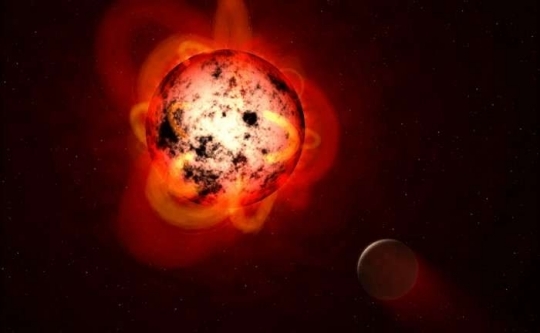
Image: A rocky planet orbiting Proxima Centauri might sustain liquid water (artist’s depiction). Credit: NASA, ESA, G. Bacon (STSc).
Astrophysical context is all, even if microbial biospheres with high levels of carbon monoxide, as Schwieterman says, “would certainly not be good places for human or animal life as we know it on Earth.” Photochemistry around such stars tells the tale. From the paper:
…the sequence of reactions that ultimately result in tropospheric OH is mediated by NUV radiation that is substantially less plentiful from M-stars such as Proxima Centauri because of lower photosphere blackbody temperatures, with the result that OH production is much less favored and consequently the sinks for CO and CH4 are much less efficient…
which leads to this:
Our results introduce some important caveats to previous suggestions for interpreting CO in planetary atmospheres, particularly for planets orbiting M dwarfs. For example, our demonstration that high CO may be achieved on inhabited planets means that while simultaneously high CO2 and CH4 with little CO is still a compelling biosignature, ambiguous scenarios with high levels of all three gases also exist, and these are mostly relevant for transit transmission observations of habitable zone planets orbiting M dwarf stars. Arguments regarding threshold CH4 levels that are incompatible with abiotic CH4 outgassing rates are in principle still valid (Krissansen-Totton et al. 2018b), but the proposal that CO provides a check on abiotic versus biological origins of CH4 is weakened by our results given likely near-future capabilities.
The ongoing examination of biosignatures is critical, for we could be looking at atmospheric analysis within a few short years. The challenge will be not only to hunt for reliable biosignatures but to avoid overlooking potentially habitable worlds. This paper indicates that two types of living world, one similar to our early Earth, the other around red dwarf stars, are able to support both life and the ready accumulation of carbon monoxide. The reminder that the photochemistry around M-dwarf stars allows substantial buildups of CO while supporting an inhabited world helps to clarify our range of interpretations.
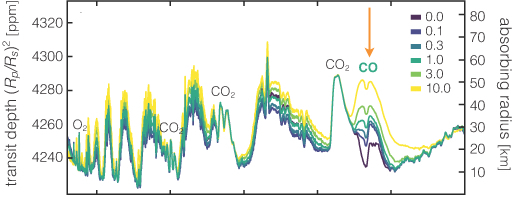
Image: Carbon monoxide features prominently in oxygen-rich atmospheres in the habitable zone of a red dwarf star like Proxima Centauri. Credit: Schwieterman et al.
Ten years from now, will we have identified unmistakable signs of life around another star? I seriously doubt it. My guess is that many of our early efforts will turn up results that are ambiguous enough to allow for a range of conclusions. Thus the need to continue cataloging alternative biosignature gases and to fine-tune the spectral capabilities of the instruments we will use to survey these atmospheres. Also in play, according to the paper, are “…searching for biogenic seasonality” and “advanced methods for calculating atmosphere-surface disequilibria.”
The paper is Schwieterman et al., “Rethinking CO Antibiosignatures in the Search for Life Beyond the Solar System,” Astrophysical Journal Vol. 874, No. 1 (15 March 2019). Abstract / full text.






March 19, 2019
Exploring our System’s Dust Lanes
Dust rings in the Solar System are of interest because they offer clues about the formation of the planets, as well as allowing us to contrast our own circumstellar dust with what we see around other stars in varying stages of planetary development. Recent work out of NASA’s Goddard Space Flight Center offers a dust ring with a difference from others we’ve found in our own system. Scientists have traced a dust ring near the orbit of Venus, and it’s one with origins different than the dust that occurs in Earth’s orbit as well as dust found near Mercury.
Explaining what is going on in Earth’s orbital path has us resort to the asteroid belt between Mars and Jupiter, where the collisions of small objects create a steady source of dust. The material drifts gradually toward the Sun, but some of it, moving near the Earth, is drawn into our planet’s orbit. A surprising amount of dust falls to Earth each day (one recent estimate is fully 60 tons of the stuff), and the mechanism seems a natural explanation for what we see at Venus.
But the explanation fails. The problem is that simulations of dust moving toward the Sun undertaken by GSFC astrophysicist Petr Pokorný produce a dust ring around the Earth but fail to generate one as dusty as the one around Venus. That sets up a series of simulations that Pokorný, working with colleague Marc Kuchner, have recently discussed in the Astrophysical Journal Letters. Their hypothesis: There exists a group of still undetected asteroids that orbit the Sun co-orbitally with Venus. Collisions between these over time account for the added dust.
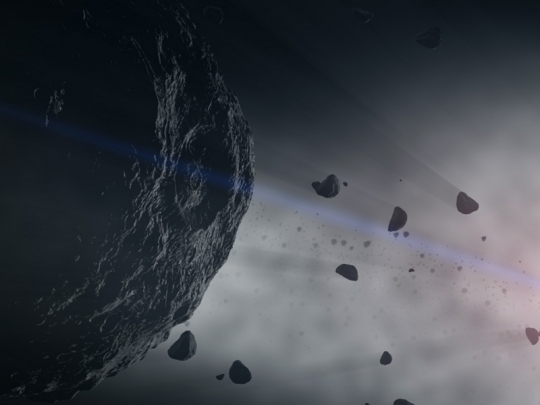
Image: Asteroids represent building blocks of the Solar System’s rocky planets. When they collide in the asteroid belt, they shed dust that scatters throughout the system, which scientists can study for clues to the early history of planets. Credit: NASA’s Goddard Space Flight Center Conceptual Image Lab.
A new population of asteroids offers an interesting observational challenge, but the dust ring involved is known to be large, about 26 million kilometers (16 million miles) thick and 10 million kilometers (6 million miles) wide. Even so, this is fairly diffuse material, only about 10 percent denser with dust than surrounding space, and accounting for it has been a challenge. The researchers tried modeling everything from long-period comets to main belt asteroids to explain it.
If asteroids move co-orbitally with Venus, perhaps in its orbit but often on the other side of the Sun, they may have gone undetected because of the difficulty in observing objects this faint so close to our star. Modeling different potential resonances, Pokorný and Kuchner find only a group of asteroids matching Venus’ orbits one for one would reproduce the dust ring.
The researchers work from the premise that this hypothesized group of asteroids has been there since the beginning of the Solar System. Modeling this scenario with a starting group of 10,000 asteroids produced a present-day population of fewer than a thousand, enough to explain the dust ring we see today. Finding such survivors will take an instrument like Hubble, but it will help us nail down the size of the population as well as its physical characteristics.
Dust rings seem to be common, given that we also have strong evidence of a dust ring around Mercury, as demonstrated by Guillermo Stenborg and Russell Howard (Naval Research Laboratory, Washington DC), who present evidence of cosmic dust in a ring some 15 million kilometers (9.3 million miles) wide over Mercury’s orbit. In a region presumed to be free of dust because of its proximity to the Sun, this ring was found using data from the STEREO satellite (Solar and Terrestrial Relations Observatory) and has implications for data gathering by the Parker Solar Probe, now operating in a highly elliptical orbit around the Sun.
“It wasn’t an isolated thing,” Howard said. “All around the Sun, regardless of the spacecraft’s position, we could see the same five percent increase in dust brightness, or density. That said something was there, and it’s something that extends all around the Sun.”
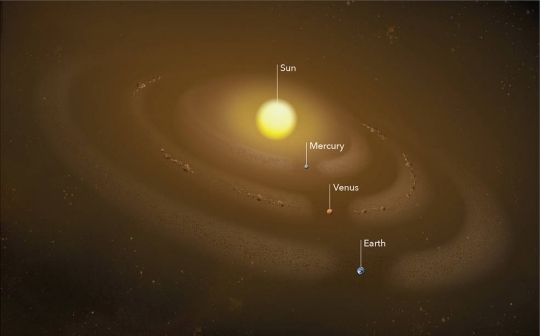
Image: In this illustration, several dust rings circle the Sun. These rings form when planets’ gravities tug dust grains into orbit around the Sun. Recently, scientists have detected a dust ring at Mercury’s orbit. Others hypothesize the source of Venus’ dust ring is a group of never-before-detected co-orbital asteroids. Credit: NASA’s Goddard Space Flight Center/Mary Pat Hrybyk-Keith.
So the solar wind and magnetic forces from the Sun have failed to sweep away the dust found at Mercury’s orbit. As we work to refine our dust models, distinguishing between coronal light and light reflecting off dust in space (which is some 100 times brighter), we’re learning how to separate out the dust signature, which is how the researchers made their unexpected discovery. “It wasn’t an isolated thing,” says Howard. “All around the Sun, regardless of the spacecraft’s position, we could see the same five percent increase in dust brightness, or density. That said something was there, and it’s something that extends all around the Sun.”
Is there a zone of dust-free space close to the Sun, as originally assumed? If so, its boundary will tell us something about the dust’s composition, with implications for early planet formation. Learning how dust near the Sun behaves should occupy scientists with the Parker Solar Probe mission as they witness first hand the environment through which their spacecraft moves.
The papers are Pokorný & Kuchner, “Co-orbital Asteroids as the Source of Venus’s Zodiacal Dust Ring,” Astrophysical Journal Vol. 873, No. 2 (12 March 2019). Abstract; and Stenborg et al., “Evidence for a Circumsolar Dust Ring Near Mercury’s Orbit,” Astrophysical Journal Vol. 868, No. 1 (21 November 2018). Abstract.






March 14, 2019
Asteroid Bennu: Changes in Rotation Rate
Tuesday’s post on asteroids and what it would take to deflect or destroy one has been usefully reinforced by a new paper from Mike Nolan (Lunar and Planetary Laboratory, University of Arizona) and colleagues, who discuss their findings in Geophysical Research Letters. Here we’re looking at observations of the near-Earth asteroid (101955) Bennu, both archival (extending back to 1999) and current, drawing on the OSIRIS-REx mission.
You’ll recall that OSIRIS-REx (Origins, Spectral Interpretation, Resource Identification, and Security–Regolith Explorer) is in operation around the asteroid, its observations helping us understand the object’s rotation, structure and composition, with a sample return planned for 2023. The Nolan paper fills us in on observed changes in rotation, which are apparent on the order of about 1 second per century. The asteroid’s rotation is speeding up.
Exactly what’s going on here is something we can hope OSIRIS-REx can help nail down. One possibility is a process like the Yarkovsky‐O’Keefe‐Radzievskii‐Paddack effect (YORP), by which asteroids are known to be affected because of the uneven distribution of solar heating across their surfaces. The effects of YORP depend on the shape and orientation of the individual asteroid and can cause either a slowdown or uptick in the object’s spin rate.
Or are there other processes at work here? Even boulders on the surface and their relative positions can play into changes in asteroid spin. It’s important to find out because over astronomical time periods, a faster spinning asteroid could eventually shed some of its mass. One thing, then, that OSIRIS-REx will be looking for is the presence of landslides or other surface evidence of such changes. Nolan points to the possibilities:
“As it speeds up, things ought to change, and so we’re going to be looking for those things and detecting this speed up gives us some clues as to the kinds of things we should be looking for. We should be looking for evidence that something was different in the fairly recent past and it’s conceivable things may be changing as we go.”
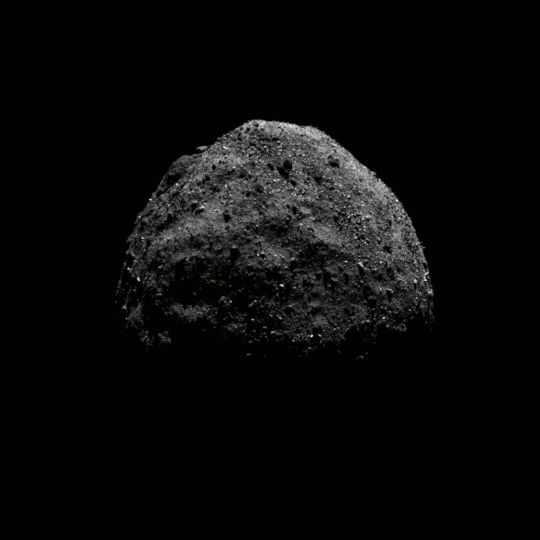
Image: This series of MapCam images was taken over the course of about four hours and 19 minutes on Dec. 4, 2018, as OSIRIS-REx made its first pass over Bennu’s north pole. The images were captured as the spacecraft was inbound toward Bennu, shortly before its closest approach of the asteroid’s pole. As the asteroid rotates and grows larger in the field of view, the range to the center of Bennu shrinks from about 11.4 to 9.3 km (7.1 to 5.8 miles). This first pass was one of five flyovers of Bennu’s poles and equator that OSIRIS-REx conducted during its Preliminary Survey of the asteroid. Credit: NASA/Goddard/University of Arizona.
We’re fortunate in having data from ground-based telescopes as well as Hubble to study the object over time. 110 million kilometers from Earth, the spinning Bennu completes a full rotation every 4.3 hours. The Hubble data on rotation rate showed a slight mismatch with the predictions of the earlier observations. And while Nolan and team point out that a change in the asteroid’s shape could account for its change in rotation, they clearly favor the YORP hypothesis. Having OSIRIS-REx at Bennu offers the opportunity to put YORP ideas to a close-up test.
The increase in Bennu’s rotation over the past two decades does not fit some earlier analyses of the YORP effect, making the spacecraft’s work all the more important. As the paper notes:
The OSIRIS-REx science team will independently measure the rotational acceleration during its 2-years of proximity operations. The precise shape determination, surface boulder distribution, gravity measurements, and thermal property determinations will allow for a better connection between the dominant drivers of the YORP effect (if confirmed) and their relative importance. The OSIRIS-REx team can measure the stability of the rotation state, to confirm whether this acceleration is a steady increase due to the YORP effect, or some other (likely episodic) process such as mass movement. Thus, our observations form a critical baseline for future work.
Within two years, we should have the OSIRIS-REx data independently providing Bennu’s rotation rate, which should help to identify the cause. We’ll also be looking at Bennu with other instruments for the next several decades to see whether further changes in rotation rate, consistent with YORP or not, emerge. Usefully, work like this allows us to compare and contrast in situ measurements with ground-based observations, giving us the chance to hone our skills at asteroid analysis for application to the larger population.
The paper is Nolan et al., “Detection of Rotational Acceleration of Bennu Using HST Light Curve Observations,” Geophysical Research Letters 31 January 2019 (abstract).






March 13, 2019
A Biosignature Plus for K-Class Stars
Kepler-62 is a reminder of how interesting K-class stars (like Alpha Centauri B) can be. Here we find two worlds that are conceivably in the habitable zone of their star, with Kepler 62f, imagined in the image below, orbiting the host star every 267 days. Kepler-62e, the bright object depicted to the right of the planet, may orbit within the inner edge of the habitable zone. Both planets are larger than Earth, Kepler 62f about 40 percent so, while Kepler-62e is 60 percent larger.
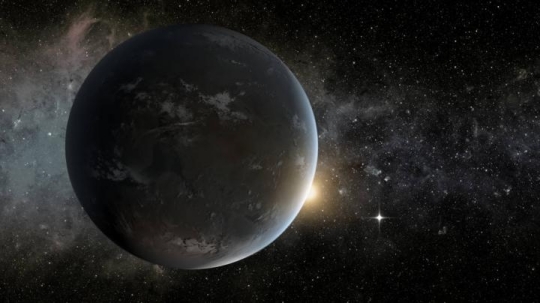
Image: The artist’s concept depicts Kepler-62f, a super-Earth-size planet in the habitable zone of a star smaller and cooler than the sun, located about 1,200 light-years from Earth in the constellation Lyra. Credit: NASA Ames/JPL-Caltech/Tim Pyle.
We actually have five planets here, all known thanks to Kepler to transit their star. The two of habitable zone interest may or may not be solid planets — their masses are not well constrained through either radial velocity or transit timing methods, so we are a long way from knowing whether life might actually form on either. Kepler-62e may well turn out to be a gaseous mini-Neptune, based on its radius. As for the host, Kepler-62 is a K-class main sequence star approximately 70 percent the mass of the Sun, and about 7 billion years old.
K-class stars, particularly those closer than Kepler-62, are seeing a flurry of interest as potential homes for life. In fact, Giada Arney (NASA GSFC) sees them as “in a ‘sweet spot’ between Sun-analog stars and M stars,” for reasons that become clear when you compare them to their smaller and cooler cousins. M-dwarfs are ubiquitous, comprising perhaps 80 percent of all stars in the galaxy, but they’re also given to severe flare activity especially in their early years, enough so that there is a real possibility of damage to the atmosphere and loss of liquid water on the surface.
Add to this problems like tidal locking that could afflict planets in the close-in habitable zone around a cool M-dwarf and by comparison, K-class stars have particular advantages. Arney’s analysis of K star habitability and biosignatures appears in Astrophysical Journal Letters, and it makes the case that a biosignature like the simultaneous presence of oxygen and methane will likely be stronger around a K star than a star like the Sun.
To examine the issue, the scientist developed a computer model simulating planetary atmospheres that could be subjected to conditions around a variety of host stars. Simulations of planetary spectra from these atmospheres could then be produced for analysis. Arney’s work shows that a habitable zone planet circling a K star is one that allows methane to build up in the atmosphere because the host star’s ultraviolet does not generate the highly reactive oxygen that destroys methane as quickly as a star like the Sun. With methane lasting longer within an oxygenated atmosphere, our chance of detecting disequilibrium between the gases increases.
We can add in another factor (one that also favors M-dwarfs): The contrast in brightness between the Sun and our Earth would, to a distant observer, be about 10 billion times, making Earth a very tricky world to observe. Whereas the contrast between a habitable zone planet and a K star is closer to 1 billion. That makes nearby K stars interesting places for future biosignature searches, allowing shorter observing times to achieve a given signal to noise ratio. The author thinks we should keep these advantages in mind as we plan future exoplanet observatories.
The paper lists some interesting targets:
These simulations suggest that nearby mid-to-late K dwarfs such as 61 Cyg A, and 61 Cyg B, Epsilon Indi, Groombridge 1618, and HD 156026 may be particularly excellent targets for biosignature searches on exoplanets. In addition to the “K dwarf advantage” for biosignatures, these stars can offer access to a wide range of wavelengths for HZ planets even with IWA [Inner Working Angle] constraints. 61 Cyg A, 61 Cyg B, Epsilon Indi, and Groombridge 1618 provide higher or comparable S/N to Tau Ceti, the closest G dwarf other than the Sun and Proxima Centauri A. In particular, 61 Cyg A and 61 Cyg B, which are at a similar distance as Tau Ceti (3.6 pc), offer S/N that is 1.6–1.7 times better in the same integration time. HD 156026 is at a similar distance as 82 Eridani (6 pc), and it offers 1.4 times better S/N compared to this G6V star.
But there is this challenge, as alluded to above: Habitable zone planets around K stars will orbit closer to their host than comparable planets around G-class stars like the Sun. That could mean that such planets fall inside the Inner Working Angle (IWA) of future observatories. The IWA defines the smallest separation between planet and star at which the planet can be resolved. Direct imaging telescopes, including the future LUVOIR and HabEx may not, then, be able to see the planet at the needed wavelengths. The paper considers starshade and coronagraph designs that could solve this problem.
The paper is Arney, “The K Dwarf Advantage for Biosignatures on Directly Imaged Exoplanets,” Astrophysical Journal Letters Vol. 873, No. 1 (6 March 2019). Abstract / full text.






March 12, 2019
Asteroids in Collision: A New Model
If we were to find an asteroid on a trajectory to impact the Earth, what strategies would we use to stop it? Recent work from Johns Hopkins University shows that there is a wide range in our thinking on what happens to asteroids under various mitigation scenarios. Much depends, of course, on the asteroid’s composition, which we must account for in our models. A good thing, then, that we are supplementing those models with sampling missions like OSIRIS-REx and Hayabusa-2.
Let’s look at the JHU work, though, which updates earlier results from Patrick Michel and colleagues, reported in a 2013 paper; the latter had considered the 5 km/s head-on impact of a 1.21 km diameter basalt impactor on a 25 km diameter target asteroid, with a model varying mass, temperature and material brittleness. Michel’s work showed evidence that the asteroid being targeted would be completely destroyed by the impactor. What Charles El Mir and colleagues at Johns Hopkins have been able to show is that other outcomes are likely.
“We used to believe that the larger the object, the more easily it would break, because bigger objects are more likely to have flaws,” says El Mir. “Our findings, however, show that asteroids are stronger than we used to think and require more energy to be completely shattered.”
Using essentially the same scenario as Michel, El Mir, K. T. Ramesh (JHU) and Derek Richardson (University of Maryland) have created a new model that offers a more detailed look at the smaller-scale processes that take place during such a collision. “Our question was, how much energy does it take to actually destroy an asteroid and break it into pieces?” adds El Mir.
Discussing methods, the authors note their model’s calculation of the first tens of seconds following impact, with transition to computer code integrating longer-term effects. From the paper:
The multi-physics material model is centered around the growth mechanism of an initial distribution of subscale flaws. Rate effects in the model are a natural outcome of the limited crack growth speed, which is explicitly computed based on the local stress state. In addition, porosity growth, pore compaction, and granular flow of highly damaged materials are captured at the material-point level. We validated the model’s predictive capability by comparing the dynamic tensile strength with high-strain-rate Brazilian disk experiments performed on basalt samples.
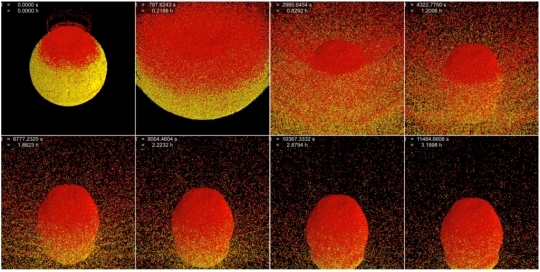
Image: A frame-by-frame showing how gravity causes asteroid fragments to reaccumulate in the hours following impact. Credit: Charles El Mir/Johns Hopkins University.
The first phase of the scenario is shown in the video below, available at https://www.youtube.com/watch?time_continue=1&v=Vt_xwQYafOY for email subscribers who would like to follow it up in their browsers. What emerges is that millions of cracks form in the asteroid as the crater is created, with the asteroid surviving the hit rather than being shattered, while the surviving core then has sufficient gravitational pull to act on the fragments swirling around it.
In the second phase, available at https://www.youtube.com/watch?time_continue=1&v=ZjBgljnCtWk, what we have left is not a rubble pile held loosely by gravity, but rather a surviving core whose fragments have been redistributed. Can we, then, hope to break an asteroid into small pieces, or is it best to find ways to nudge the entire object onto a new trajectory? The latter still involves the question of asteroid survivability, as we need to move it without breaking it into smaller impactors.
The paper shows the capability of the parent asteroid to withstand huge shock:
The collision imparted substantial damage onto the target, with most of the damage localized under the impact site, resulting in a heavily fractured but not fully damaged “core”. The material points were then converted into soft spheres and handed over to pkdgrav [the modeling software] in a self-consistent manner to calculate the gravitational interaction of the ejected material. We observed substantial ejecta fallback onto the largest remnant of the parent body, with a recovered mass of the largest remnant being 0.85 that of the parent body, indicating that the disruption thresholds for such targets may be higher than previously thought.
Thinking ahead to asteroid mitigation strategies is simple prudence, and requires continuing study of how asteroids respond to the various methods now under consideration to destroy them or change their trajectory. This paper gives us a glimpse of the changing parameters of research on the matter, a window into the ongoing analysis that will refine our planning.
The paper is El Mir et al., “A new hybrid framework for simulating hypervelocity asteroid impacts and gravitational reaccumulation,” Icarus Vol. 321 (15 March 2019), pp. 1013-1025 (abstract). The Michel paper is “Collision and gravitational reaccumulation: Possible formation mechanism of the asteroid Itokawa,” Astronomy & Astrophysics 554, L1 (abstract).






March 11, 2019
A Sparse Population of Small Kuiper Belt Objects?
One problem with learning about the Kuiper Belt is that objects out there are small and details from Earth-based imaging all too sparse. New Horizons yielded up a world of wonders with Pluto, showing us nitrogen glaciers, and mountains fully 4 kilometers tall. But even relative proximity doesn’t help us in some areas. Pluto’s surface has seen enough geologic activity that evidence of its impact history is sparse. Where to turn to learn what has hit it, and when?
The large moon Charon may provide some answers. Unlike Pluto, its surface is relatively stable, giving us insights deep into the past. And we learn from a new paper by Kelsi Singer (SwRI) that there is a surprising lack of craters here nonetheless. The craters we do see on the two worlds were, according to the paper, formed by objects with diameters ranging from ~40 kilometers to ~300 meters, making them smaller than most KBOs we can observe with our telescopes.
Thus a measure of how much in the dark we are about the nature of KBOs. Even Pluto, with resurfacing at work through geological processes, should show more signs of small craters of 13 kilometers or less in diameter. Their lack seems to make small KBOs — ≲1 to 2 kilometers in diameter — very sparse. The work, which appears in Science, implies that there are major differences between the Kuiper Belt and the closest analogue in our system, the main asteroid belt. Says Singer:
“This surprising lack of small KBOs changes our view of the Kuiper Belt and shows that either its formation or evolution, or both, were somewhat different than those of the asteroid belt between Mars and Jupiter. Perhaps the asteroid belt has more small bodies than the Kuiper Belt because its population experiences more collisions that break up larger objects into smaller ones.”
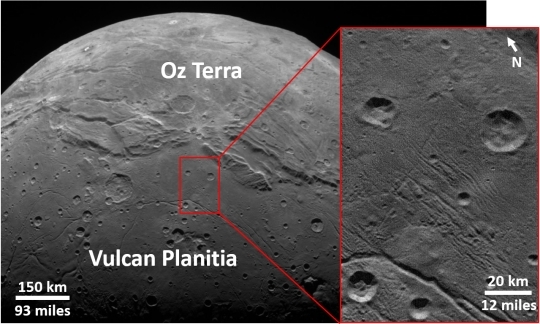
Image: An SwRI-led team studied the craters and geology on Pluto and Charon and found there were fewer small craters than expected. This implies that the Kuiper Belt contains relatively small numbers of objects less than 1.6 kilometers in diameter. Imaged by New Horizon’s LORRI camera, the smooth, geologically stable “Vulcan Planitia” on Charon illustrates these findings. Credit: Courtesy of NASA/JHU/LORRI/SwRI.
We’re still early in the analysis of data from the Ultima Thule flyby, so we don’t want to read too much into this, but it does appear that Ultima supports the same lack of cratering. That’s intriguing because we’re dealing with formation models of the Solar System, which can produce different outcomes and hence populations of objects depending on their inputs. We’re thus homing in on information about the early formation of the Solar System as we analyze the differences between the two belts of debris in their respective positions around the Sun.
Sorting this out will be a lengthy process, dependent upon leveraging data on the three surfaces we’ve been able to study up close through New Horizons, and future data from continued observation (and, let’s assume, additional space missions, including a New Horizons flyby in a future extended mission). Remember that some of the surfaces we’ve seen on Pluto and Charon are likely to be over 4 billion years old, making this analysis of the size and frequency distribution of KBOs provocative.
Interestingly, the paper speculates that if the lack of smaller KBOs is primordial (as opposed to being the result of, say, structural properties of KBOs themselves), this may be consistent with “dynamical models of gravitational instabilities causing rapid growth to larger objects.” Such models produce fewer small bodies and fewer collisions overall. The paper concludes:
There may be more than one combination of processes that can produce the observed KBO SFD [size-frequency distribution]. If there are fewer small objects in the outer Solar System, the probability of collisions is lower, and comets such as 67P/Churyumov–Gerasimenko are less likely to be affected by many catastrophic collisions throughout their lifetimes… By providing constraints on a size range of KBOs not currently accessible by telescopes, the New Horizons crater data can help discriminate between models of accretion, evolution, and/or emplacement of the Kuiper belt.
And dropping back to 1990, we might note another surface, this one of a likely captured KBO, that we viewed from Voyager. I’m pointing to a paper from Robert Strom (Lunar and Planetary Laboratory, University of Arizona) and colleagues on impact cratering on Neptune’s large moon Triton. The scientists found few impact craters on Triton thanks to recent resurfacing from icy melts, with the most heavily cratered surfaces, found on the leading hemisphere in Triton’s orbit, having a crater density about the same as the lunar maria. The scientists argue that some of the craters in Triton’s so-called ‘cantaloupe’ terrain may well be the result of volcanic activity.
The paper is Singer et al., “Impact craters on Pluto and Charon indicate a deficit of small Kuiper Belt objects,” Science Vol. 363, Issue 6430 (01 March 2019), pp. 955-959 (abstract). The Strom paper is “The Impact Cratering Record on Triton,” Science Vol. 250, Issue 4979 (19 October 1990), pp. 437-439 (abstract).






March 8, 2019
Confirming Kepler-1658b: Tight Orbit around an Evolved Star
A planet designated Kepler-1658b is, after a good deal of investigation, demonstrated to be a ‘hot Jupiter,’ orbiting a star that is 50 percent more massive and three times larger than the Sun. The sizzling world is close enough to its star that were you to look into its sky from near the planet, the star would be 60 times larger than the Sun as seen from Earth. And while none of this makes Kepler-1658b unique in our catalog, what does stand out is how we learned all this.
For we are talking about the first planet candidate ever uncovered with the Kepler Space Telescope. Recall that for any transiting planet to be considered confirmed, we need a second kind of detection. The reason: Various astrophysical processes can mimic transit activity. Prudence dictates the backup, and in the case of Kepler-1658b, both the initial estimate of the star’s size and the size of the planet were underestimated. The result was that the putative world became thought of as a false positive whose numbers didn’t check.
Three of the stars in the Kepler field were already known to have planets from ground-based transit observations when the mission launched in 2009, and these three targets became the first designated Kepler Objects of Interest (KOI). What would be labeled KOI 4.01, Kepler’s first new planet candidate, was given a stellar radius of 1.1 times that of the Sun, with an initial transit depth implying that the star was orbited by a Neptune-class planet. A new paper on Kepler-1658b goes through the history of its description and subsequent catalog listings.
The detection remained a false positive, though, until a graduate student at the University of Hawai’i named Ashley Chontos reanalyzed the problematic find:
“Our new analysis,” says Chontos,” which uses stellar sound waves observed in the Kepler data to characterize the host star, demonstrated that the star is in fact three times larger than previously thought. This in turn means that the planet is three times larger, revealing that Kepler-1658 b is actually a hot Jupiter-like planet.”
Armed with that information, Chontos contacted Dave Latham (Smithsonian Astrophysical Observatory), whose team went to work culling the needed spectroscopic data to make a radial-velocity call on the planet. Newly confirmed, Kepler-1658b turns out to orbit at a distance only twice the diameter of the host star, making its orbit one of the closest we’ve found to an evolved star (one that has exhausted the hydrogen fuel in its core and, drawing on nuclear reactions outside the core, is passing through the subgiant phase and swelling into a red giant).
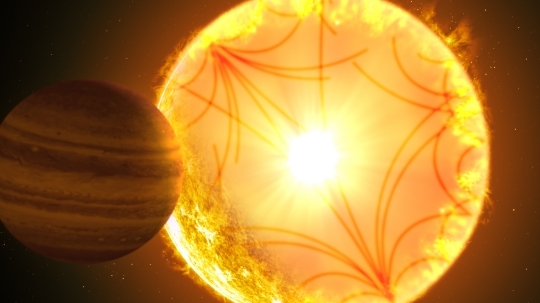
Image: Artist’s concept of a Kepler-1658-like system. Sound waves propagating through the stellar interior were used to characterize the star and the planet. Kepler-1658b, orbiting with a period of just 3.8 days, was the first exoplanet candidate discovered by Kepler nearly 10 years ago. Credit: Gabriel Perez Diaz/Instituto de Astrofísica de Canarias.
This is an interesting find for more than its significance as the first Kepler exoplanet. We know of few planets orbiting stars of this class, a deficit not yet understood. From the paper:
Systems like KOI 4.01 are interesting because giant planets at short orbital periods (P < 100 days) are rare around subgiant stars (e.g. Johnson et al. 2007, 2010; Reffert et al. 2015; Lillo-Box et al. 2016; Veras 2016), although the reason for this is still a topic of debate. On one hand, this may be related to the stellar mass. Subgiant host stars are thought to be more massive than main sequence stars targeted for planet detection. A higher mass could shorten the lifetime of the protoplanetary disk and lead to fewer short-period giant planets orbiting these type of stars (e.g. Burkert & Ida 2007; Kretke et al. 2009). Other authors have suggested that subgiants have fewer short-period planets because these objects may get destroyed by tidal evolution, which is likely stronger for more evolved stars (e.g. Villaver & Livio 2009; Schlaufman & Winn 2013). Distinguishing between those scenarios is further complicated by the fact that it is challenging to derive stellar masses of evolved stars (Lloyd 2011, 2013; Johnson et al. 2013; Ghezzi et al. 2018).
Thus Kepler-186b is a useful outlier that helps us put constraints on what happens as planets approach a death spiral into their star. And another exoplanet mission may provide a useful cross-check:
The Kepler field will be observed by the Transiting Exoplanet Survey Satellite (TESS; Ricker et al. 2015) in mid-2019. Extending the baseline of transit observations to over a decade for Kepler-1658 will allow for a stronger constraint on orbital period decay in more evolved systems. Extrapolating our period decay analysis to the time Kepler-1658 would be observed by TESS would rule out another order of magnitude for the tidal quality factor in subgiant stars.
The paper is Chontos et al., “The Curious Case of KOI 4: Confirming Kepler’s First Exoplanet Detection,” accepted at the Astronomical Journal (preprint).






March 6, 2019
Black Hole Propulsion as Technosignature
When he was considering white dwarfs and neutron stars in the context of what he called ‘gravitational machines,’ Freeman Dyson became intrigued by the fate of a neutron star binary. He calculated in his paper of the same name (citation below) that gradual loss of energy through gravitational radiation would bring the two neutron stars together, creating a gravitational wave event of the sort that has since been observed. Long before LIGO, Dyson was talking about gravitational wave detection instruments that could track the ‘gravitational flash.’
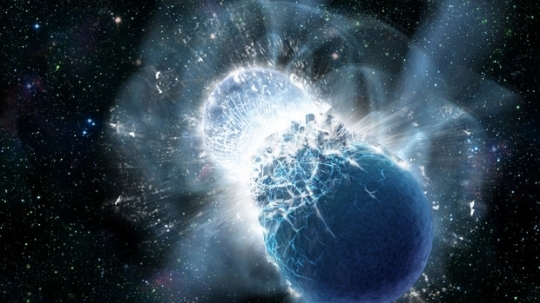
Image: Artist conception of the moment two neutron stars collide. Credit: LIGO / Caltech / MIT.
Observables of this kind, if we could figure out how to do it (and we subsequently have) fascinated Dyson, who was in this era (early 1960s) working out his ideas on Dyson spheres and the capabilities of advanced civilizations. As to the problematic merger of neutron stars in a ‘machine,’ he naturally wondered whether astrophysical evidence of manipulations of these would flag the presence of such cultures, noting that “…it would be surprising if a technologically advanced species could not find a way to design a nonradiating gravitational machine, and so to exploit the much higher velocities which neutron stars in principle make possible.”
He goes on in the conclusion to the “Gravitational Engines” paper to say this: “In any search for evidences of technologically advanced societies in the universe, an investigation of anomalously intense sources of gravitational radiation ought to be included.”
Searching for unusual astrophysical activity is part of what would emerge as ‘Dysonian SETI,’ or in our current parlance, the search for ‘technosignatures.’ It’s no surprise that since he discusses using binary black holes as the venue for his laser-based gravity assist, David Kipping should also be thinking along these lines. If the number of black holes in the galaxy were large enough to support a network of transportation hubs using binary black holes, what would be the telltale sign of its presence? Or would it be observable in the first place?
Remember the methodology: A spacecraft emits a beam of energy at a black hole that is moving towards it, choosing the angles so that the beam returns to the spacecraft (along the so-called ‘boomerang geodesic’). With the beam making the gravitational flyby rather than the spacecraft, the vehicle can nonetheless exploit the kinetic energy of the black hole for acceleration. Huge objects up to planetary size could be accelerated in such a way, assuming their mass is far smaller than the mass of the black hole. No fuel is spent aboard the spacecraft which, using stored energy from the beam, continues to accelerate up to terminal velocity.
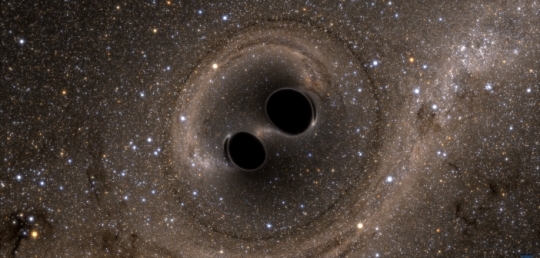
Image: Simulated image of the two merging black holes detected by LIGO, viewed face-on. LIGO’s gravitational-wave detection is the first direct observation of such a merger. Credit: LIGO / AAS Nova.
Kipping likes to talk about the process in terms of a mirror. Because light loops around the approaching black hole and returns to the spacecraft, the black hole exhibits mirror-like behavior. Thus on Earth, if we bounce a ping-pong ball off a mirror, the ball returns to us. But if the mirror is moving towards us quickly, the ball returns faster because it has picked up momentum from the mirror. Light acts the same way, but light cannot return faster than the speed of light. Instead, in gaining momentum from the black hole, the light blueshifts.
We exploit the gain in energy, and we can envision a sufficiently advanced civilization doing the same. If it can reach a black hole binary, it has gained an essentially free source of energy for continued operations in moving objects to relativistic speeds. Operations like these at a black hole binary result in certain effects, so there is a whisper of an observable technosignature.
I discussed the question with Kipping in a recent email exchange. One problem emerges at the outset, for as he writes: “The halo drive is a very efficient system by design and that’s bad news for technosignatures: there’s zero leakage with an idealized system.” But he goes on:
The major effect I considered in the paper is the impact on the black hole binary itself. During departure, one is stealing energy from the black binary, which causes the separation between the two dead stars to shrink slightly via the loss of gravitational potential energy. However, an arriving ship would cancel out this effect by depositing approximately the same energy back into the system during a deceleration maneuver. Despite this averaging effect, there is presumably some time delay between departures and arrivals, and during this interval the black hole binary is forced into a temporarily contracted state. Since the rate of binary merger via gravitational radiation is very sensitive to the binary separation, these short intervals will experience enhanced infall rates. And thus, overall, the binary will merge faster than one should expect naturally. It may be possible to thus search for elevated merger rates than that expected to occur naturally. In addition, if the highway system is not isotropic, certain directions are preferred over others, then the binary will be forced into an eccentric orbit which may also lead to an observational signature.
Tricky business, this, for a black hole binary in this formulation can be used not only for acceleration but deceleration. The latter potentially undoes the distortions caused by the former, though Kipping believes elevated merger rates between the binary pair will persist. Our technosignature, then, could be an elevated binary merger rate and excess binary eccentricity.
I was also interested in directionality — was the spacecraft limited in where it could go? I learned that the halo drive would be most effective when moving in a direction that lies along the plane of the binary orbit. Traveling out of this plane is possible, though it would involve using onboard propellant to attain the correct trajectory. The potential of reaching the speed of the black hole itself remains, but excess stored energy would then need to be applied to an onboard thruster to make the course adjustment. Kipping says he has not run the numbers on this yet, but from the work so far be believes that a spacecraft could work with angles as high as 20 degrees out of the plane of the binary orbit and still reach an acceleration equal to that of the black hole.
For more on the halo drive, remember that Kipping has made available a video that you can access here. The other citations are Kipping, “The Halo Drive: Fuel-free Relativistic Propulsion of Large Masses via Recycled Boomerang Photons,” accepted at the Journal of the British Interplanetary Society (preprint); and Dyson, “Gravitational Machines,” in A.G.W. Cameron, ed., Interstellar Communication, New York: Benjamin Press, 1963, Chapter 12.






March 5, 2019
Investigating the ‘Halo Drive’
One of the interesting things about gravitational assists is their ability to accelerate massive objects up to high speeds, provided of course that the astrophysical object being used for the assist is moving at high speeds itself. Freeman Dyson realized, as we saw yesterday, that a pair of tightly rotating white dwarfs could offer such an opportunity, while a binary neutron star carried even more clout. When Dyson was writing his “Gravitational Machines” paper, neutron stars were still a theoretical concept, so he primarily focused the paper on white dwarfs.
Get two neutron stars in a tight enough orbit and the speeds they achieve would make it possible to accelerate a spacecraft making a gravity assist up to a substantial percentage of lightspeed. But what an adventure that close pass would be — the tidal forces would be extreme. I don’t recall seeing a neutron star propulsive flyby portrayed in science fiction (help me out here), though Gregory Benford offers a variant on the white dwarf idea in his early work Deeper than the Darkness (1970, later re-done as The Stars in Shroud, which ran in Galaxy in 1978), where a neutron star and an F-class star comprise a system he calls a ‘Flinger,’ with potential uses both for acceleration and deceleration.
David Kipping’s thoughts on extending Dyson to black holes were partially triggered by a fascinating paper from William Stuckey in 1993 entitled “The Schwarzschild Black Hole as a Gravitational Mirror” (citation below). The gravitational mirror in the title is what happens when photons skim near the event horizon and return to the source, a photon ‘boomerang’ that gains propulsive impact because the returning light rays receive a blueshift thanks to the black hole’s relative motion.

Thus the Kipping concept: Use laser beaming technologies to beam toward a precisely targeted member of a black hole binary. The light is returned in blue-shifted form to the spacecraft, the extra energy being used to push the craft. What’s especially intriguing here is that in this scenario, it is not the spacecraft that is making the messy plunge between two rapidly moving, tightly orbiting black holes, but rather the photon beam that is used for propulsion.
It is the light beam that gets the gravitational assist as photons are re-emitted and re-absorbed, for as the paper puts it, “…the halo drive transfers kinetic energy from the moving black hole to the spacecraft by way of a gravitational assist.” A less harrowing experience for any crew, to be sure, and one in which extreme time dilation can be avoided, not to mention the dangers of tidal disruption and radiation referred to above.
Image: David Kipping (Columbia University), creator of the ‘halo drive’ concept.
Kipping described the idea to me in an email recently:
The idea is to essentially to perform a Dyson slingshot remotely, by firing a collimated particle/energy beam just to the side of the event horizon of a Schwarzchild black hole. If you choose the angle carefully, the beam loops around (like a halo) and comes back to you. If the black hole is moving towards you (I envisaged a compact binary like Dyson), then the beam returns blue shifted. When you initially fire the beam, your ship receives a small momentum kick and when the beam returns and strikes your ship you get another. This is how the ship is propelled, much like a light sail. But the beam actually returns with more energy than it departed, since it siphoned some of the kinetic energy from the black hole. So not only did you accelerate, but your ship actually gained stored energy.
Do this right and the speed of your spacecraft eventually matches that of the black hole, but the cumulative blue shifts allow the craft to continue firing the laser past that point. No new ‘free’ energy is gained but energy from the stored cells aboard the craft can keep the acceleration going up to, the author calculates, 4/3 the speed of the black hole. It’s interesting to note that we are not limited to small masses in such a calculation. Unlike the Breakthrough Starshot energy issue we discussed yesterday, we can drive arbitrarily large masses up to potentially relativistic speeds. All of this by exploiting the fantastic energies available through astrophysical objects.

Image: This is Figure 1 from the paper. Caption: Figure 1. Outline of the halo drive. A spaceship traveling at a velocity βi emits a photon of frequency νi at a specific angle δ such that the photon completes a halo around the black hole, returning shifted to νf due to the forward motion of the black hole, βBH. Credit: David Kipping.
As you would imagine, for the gravitational mirror to function in this way, the beam must be precisely oriented. From the paper:
In order for the deflection to be strong enough to constitute a boomerang, this requires the light’s closest approach to the black hole to be within a couple of Schwarzschild radii, RS ≡ 2GM/c2. Light which makes a closest approach smaller than 3GM/c2 becomes trapped in orbit, known as the photon sphere, and thus typical boomerang geodesics skim just above this critical distance [italics mine].
Kipping calls this a ‘halo drive’ because the photons returning to the craft appear as a halo around the black hole. Single black holes as well as binaries can be used (and evidently Kerr black holes as well as Schwarschild black holes, though the author plans future work on this), but the paper notes that the potential for tight configurations at relativistic speeds makes binaries preferable. 10 million binary black holes are thought to exist in the galaxy [I’ve seen this figure reduced to 1 million recently — clearly, the issue is still open], raising the possibility of a network of starship acceleration points or, for that matter, deceleration stations.
A range of possible uses for binary black holes emerges, as the paper notes:
Although not the focus of this work, it is worth highlighting that halo drives could have other purposes besides just accelerating spacecraft. For example, the back reaction on the black hole taps energy from it, essentially mining the gravitational binding energy of the binary. Similarly, forward reactions could be used to not only decelerate incoming spacecraft but effectively store energy in the binary like a fly-wheel, turning the binary into a cosmic battery.
Another possibility is that the halos could be used to deliberately manipulate black holes into specific configurations, analogous to optical tweezers. This could be particularly effective if halo bridges are established between nearby pairs of binaries, causing one binary to excite the other. Such cases could lead to rapid transformation of binary orbits, including the deliberate liberation of a binary.
A natural question is why an interstellar civilization, one already capable of reaching a black hole binary and manipulating it in this manner would need to establish a galactic network of transit points. A possible answer is that the amount of energy liberated from such a black hole binary is, as with other kinds of gravitational assist, arriving essentially ‘free’ at the spacecraft. Thus a transportation network on the cheap could be established between specific locations, a mechanism for cost-savings that may well be too efficient to ignore.
Freeman Dyson’s interest in using astrophysical objects for propulsion included, of course, his abiding fascination with the technosignatures of advanced civilizations. Would a galactic infrastructure at work in the galaxy exhibit evidence of its use to distant astronomers? In my next post, I’ll look into the possibility.
The Dyson paper is “Gravitational Machines,” in A.G.W. Cameron, ed., Interstellar Communication, New York: Benjamin Press, 1963, Chapter 12. The Kipping paper is “The Halo Drive: Fuel-free Relativistic Propulsion of Large Masses via Recycled Boomerang Photons,” accepted at the Journal of the British Interplanetary Society (preprint). The Stuckey paper is “The Schwarzschild Black Hole as a Gravitational Mirror,” American Journal of Physics Vol. 61, Issue 5 (1993), pp. 448-456.






Paul Gilster's Blog
- Paul Gilster's profile
- 7 followers



